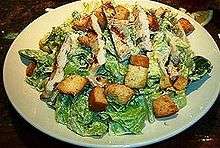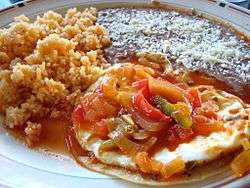Caesar salad
.jpg) A Caesar salad | |
| Course | Hors d'œuvre, salad |
|---|---|
| Place of origin | Mexico |
| Region or state | Tijuana, Baja California |
| Creator | Caesar Cardini |
| Serving temperature | Chilled or room temperature |
| Main ingredients | Romaine lettuce, croutons, Parmesan cheese, lemon juice, olive oil, egg, Worcestershire sauce, black pepper |
| Variations | Multiple |
|
| |
.jpg)
A Caesar salad is a salad of romaine lettuce and croutons dressed with parmesan cheese, lemon juice, olive oil, egg, Worcestershire sauce, garlic, and black pepper. It is often prepared tableside.[1]
History
The salad's creation is generally attributed to restaurateur Caesar Cardini, an Italian immigrant who operated restaurants in Mexico and the United States.[2] Cardini was living in San Diego but also working in Tijuana where he avoided the restrictions of Prohibition.[3] His daughter Rosa (1928–2003) recounted that her father invented the dish when a Fourth of July 1924 rush depleted the kitchen's supplies. Cardini made do with what he had, adding the dramatic flair of the table-side tossing "by the chef."[4] A number of Cardini's staff have said that they invented the dish.[5][6]
Julia Child said that she had eaten a Caesar salad at Cardini's restaurant when she was a child in the 1920s.[7] The first documentation of Caesar salad dates to 1946, when the newspaper columnist Dorothy Kilgallen wrote:
The big food rage in Hollywood—the Caesar salad—will be introduced to New Yorkers by Gilmore's Steak House. It's an intricate concoction that takes ages to prepare and contains (zowie!) lots of garlic, raw or slightly coddled eggs, croutons, romaine, anchovies, parmeasan [sic] cheese, olive oil, vinegar and plenty of black pepper.[8]
Recipe
According to Rosa Cardini, the original Caesar salad (unlike his brother Alex's Aviator's salad)[5] did not contain pieces of anchovy; the slight anchovy flavor comes from the Worcestershire sauce. Cardini was opposed to using anchovies in his salad.[9]
In the 1970s, Cardini's daughter said that the original recipe included whole lettuce leaves, which were meant to be lifted by the stem and eaten with the fingers; coddled eggs; and Italian olive oil.[7]
Bottled Caesar dressings are now produced and marketed by many companies.
The trademark brands, "Cardini's", "Caesar Cardini's" and "The Original Caesar Dressing" are all claimed to date to February 1950, though they were only registered decades later,[10] and more than a dozen varieties of bottled Cardini's dressing are available today, with various ingredients.
Many variations of the salad exist; for example, by topping a Caesar salad with grilled chicken, steak, or seafood. Certain Mexican restaurants may improvise on items such as substituting tortilla strips for croutons or Cotija cheese for the Parmesan.
Ingredients
.jpg)
Common ingredients in many recipes:[11]
- romaine or cos lettuce
- olive oil
- crushed garlic
- salt
- black pepper
- lemon juice
- Worcestershire sauce
- raw or coddled eggs
- grated Parmesan cheese
- croutons
Variations

There are limitless variations. However, some of the more common are:
- other varieties of lettuce
- grilled poultry (most often chicken), meat, shellfish, or fish
- capers
- Romano cheese
- anchovies
- bacon
Health concerns
There is inherent risk of infection by salmonella bacteria occasionally found in raw egg from cracked or improperly washed eggshells.[12] This is a concern with many similar dressings that are emulsified with eggs, though generally the pH level is thought to be acidic enough to kill those bacteria. Nevertheless, later versions of the recipe call at least for briefly cooked coddled eggs or pasteurized eggs. Recipes may omit the egg and produce a "Caesar vinaigrette". Many variations of this salad exist; yogurt is sometimes substituted for the eggs to maintain a creamy texture and others call for using mayonnaise, oil and vinegar.
See also
References
- ↑ Burke, David; Choate, Judith (2009). "Caesar Salad". David Burke's New American Classics. Knopf Doubleday Publishing Group. p. 67. ISBN 9780307519436. Retrieved July 12, 2016.
- ↑ "Cesar Cardini, Creator of Salad, Dies at 60". Los Angeles Times. November 5, 1956.
Caesar Cardini, 60, credited with the invention of the Caesar salad, died [...]
- ↑ "Rosa Cardini". The Telegraph. September 21, 2003. Retrieved 2012-02-10.
Rosa Cardini, who has died in California aged 75, turned the salad dressing created by her father, Caesar, into a staple of modern dining and a million-dollar business. Although the origin of the Caesar Salad is a topic hotly debated by epicures, the generally accepted version is that it was first popularised in the United States in the late 1920s by an Italian immigrant, born Cesare Cardini. He and his brother Alessandro moved to San Diego from Milan after the Great War and then decided to open a restaurant just across the border in Tijuana, Mexico, to attract Americans frustrated by Prohibition.
- ↑ 1987 interview with Rosa Cardini, for Mailpac Magazine, LA.
- 1 2 In "Hail Caesar", D. Grant quotes Aviator's salad and more (2007)
- ↑ 1998 notes on claims:
"Paul Maggiora, a partner of the Cardini's, claimed to have tossed the first Caesar's salad in 1927 for American airmen from San Diego and called it "Aviator's Salad. Caesar's brother Alex had claimed to have developed the salad (he too allegedly called it "aviator's salad"). Livio Santini claimed he made the salad from a recipe of his mother, in the kitchen of Caesar's restaurant when he was 18 years old, in 1925, and that Caesar took the recipe from him. - 1 2 Julia Child; Paul Child (1975). From Julia Child's Kitchen. Alfred A. Knopf. ISBN 978-0394480718.
- ↑ Dorothy Kilgallen, The Voice of Broadway, News-Herald, Franklin, Penn. (Aug. 2, 1946).
- ↑ "My father always used Lea and Perrins Worcestershire sauce, and anchovies are one of its ingredients. [...] He meant this to be a subtle salad, and anchovies can be overwhelming." (Above quoted 1987 interview with Rosa Cardini)
- ↑ United States Patent and Trademark Office, serial numbers 73426710 "Cardini's", registered 1983 by Caesar Cardini Foods, 73782270 "The Original Caesar Dressing" and "Caesar Cardini's", registered 1989 by Dolefam Corporation, which later merged with T. Marzetti, Search at http://tess2.uspto.gov
- ↑ "Caesar Salad". www.bettycrocker.com. Retrieved 7 November 2014.
- ↑ U.S. Department of Agriculture Food Safety and Inspection Service Egg Products and Food Safety
Bibliography
- Julia Child; Paul Child (1975). From Julia Child's Kitchen. Alfred A. Knopf. ISBN 978-0394480718.
Further reading
- Greenfield, Terry D. (1996). Lorna Bolkey; Kathryn Hall, eds. In Search of Caesar—The Ultimate Caesar Salad Book. Alexander Books. ISBN 978-1570900143.
- Mariani, John F. (1985). The Dictionary of American Food and Drink. Book Sales. ISBN 978-0899191997.
- Stradley, Linda; Andra Cook (1997). What's Cooking America. Chehalem Publishing. ISBN 978-1885221551.
- Trager, James (1995). The Food Chronology: A Food Lover's Compendium of Events and Anecdotes, from Prehistory to the Present. Henry Holt and Company. ISBN 978-0805033892.}
.jpg)
